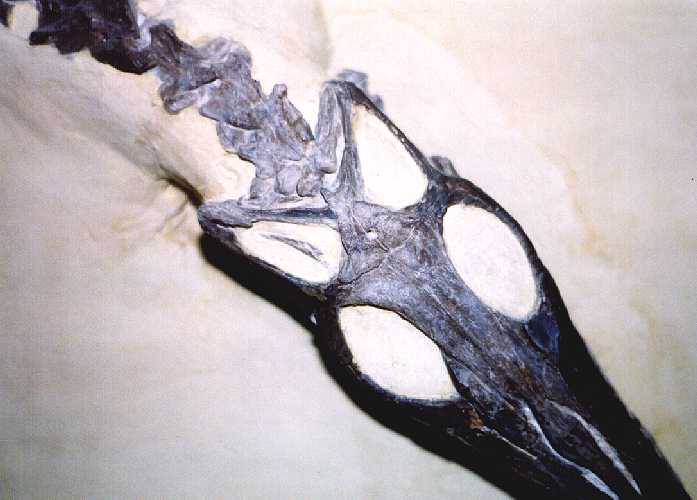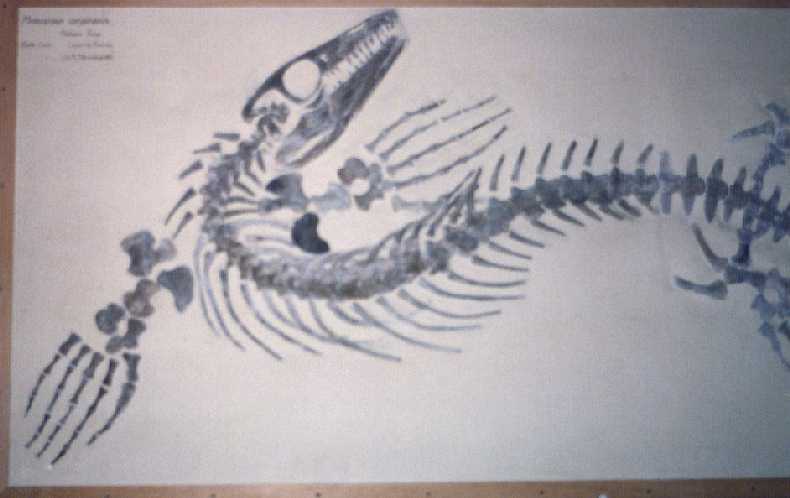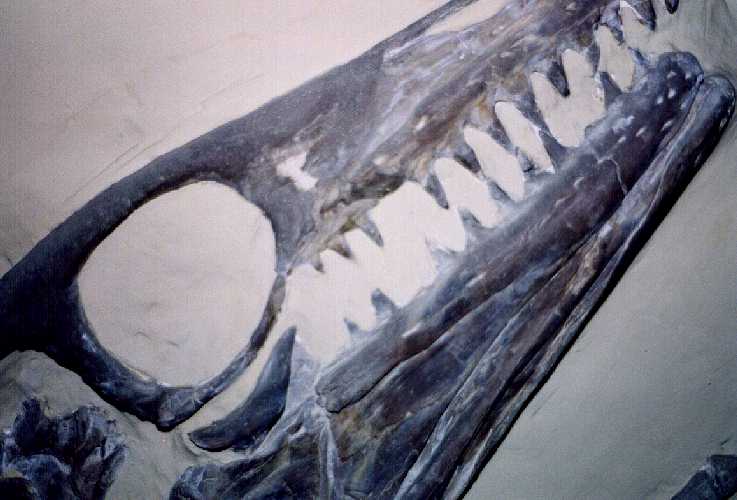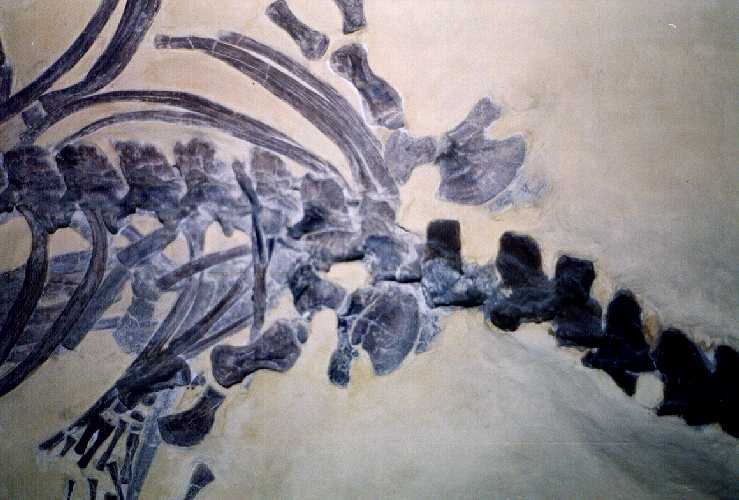[Recent Entries][Archive][Friends][User Info]
January 28th, 2014
| January 28th, 2014 | |
|---|---|
| 01:43 pm [industrialterro] [Link] |
Dallasaurus Dallasaurus is a basal mosasauroid from the Upper Cretaceous of North America. Along with Russellosaurus, Dallasaurus is one of the two oldest mosasauroid taxa currently known from North America. This small semi-aquatic lizard measured less than a meter in length, compared to such gigantic derived mosasaurs as Tylosaurus and Mosasaurus, each exceededing 15 meters. In appearance, it was similar to its closest living relative, the Komodo Dragon. The genus is based upon two partial skeletons recovered from the Arcadia Park Shale (lower Middle Turonian), approximately 15 meters above its contact with the older Kamp Ranch Limestone in Dallas County in north-central Texas. The holotype specimen (TMM 43209-1, Texas Memorial Museum, University of Texas at Austin) consists of an incomplete and disarticulated skull, along with considerable portions of the postcranial skeleton, making up about 80 percent of the animal. The second referred specimen (DMNH 8121-8125, 8143-8149, and 8161-8180, Dallas Museum of Natural History) lacks any skull material and consists entirely of disarticulated postcranial remains. The strata containing these fossils were temporarily exposed during excavations for a housing development, and both sites have now been reburied by construction. The two specimens were discovered about 100 meters from one another; the first was found by an amateur collector, Van Turner, for whom the type species (Dallasaurus turneri) was named. The genus is named for Dallas County, where both specimens were found. Polcyn and Bell diagnose Dallasaurus as follows: "Small, plesiopedal mosasauroid possessing the following autapomorphies: posterior maxillary teeth strongly recurved posteriorly, slightly inflated at the crown and bearing only posterior carinae that is slightly offset laterally; atlas neural arch mediolaterally compressed but not flattened at its base, condylar surfaces irregularly figure-eight shaped; cervical vertebra synopophyses protrude below the level of the ventral edge of the centrum; short, wide fossa excavated immediately below the ventral rim of the cotyle of at least one middle cervical vertebra; hypapophysis anteroventral edge terminating in short projections of irregular length; postglenoid process capped by bony epiphysis bearing a calcified cartilage apex." Bell and Polcyn use the term "plesiopedal" to indicate a "conservative ecologically adaptive grade" characterized by "small size, slightly modified swimming tail and [a] relatively plesiomorphic limb condition" compared to more derived mosasauroids. Polcyn and Bell note that plesiopedal mosasauroids tend to be relatively small lizards possessing limbs in which the "propodial elements [equals humerus, radius, and ulna] remain elongated, generally constituting one-half or more of the full length of the osseus limb", as compared to more derived "hydropedal" mosasaurs in which the propodial elements are stout and have been substantially shortened, constituting less than one-half of the full length of the ossueus limb. While hydropedal mosasaurs were probably entirely aquatic, plesiopedal mosasauroids were still capable of terrestrial locomotion and so likely lived an amphibious lifestyle. Bell and Polcyn have conducted a cladistic analysis of Dallasaurus, concluding that this taxon should be placed within the subfamily Mosasaurinae, "well within [the family] Mosasauridae", and that, despite its small size and the "primitive" condition of its limbs, it should not be placed within the paraphyletic family Aigialosauridae. Dallasaurus is the sister group to more derived mosasaurine mosasaurs such as Clidastes, Prognathodon, Mosasaurus, and Plotosaurus. In the popular press, Dallasaurus has been hailed as a "missing link" uniting fully aquatic mosasaurs with their terrestrial ancestors. Размеры тела в сравнении с человеком: Tags: Вымершие рептилии, Мел, варанообразные, диапсиды, лепидозавроморфы, лепидозавры, мозазавриды, мозазавроиды, чешуйчатые, ящерицы |
| Time | Event |
| 02:02 pm [industrialterro] [Link] |
Eonatator Eonatator is a genus of halisaurine mosasaur from the Upper Cretaceous of North America and Europe. Originally, this taxon was included within Halisaurus, but was placed in its own genus. Eonatator is presently known from the Smoky Hill Chalk Member of the Niobrara Chalk Formation (Upper Coniacian - Lower Campanian) of Kansas, from the Eutaw Formation (Santonian) and Mooreville Chalk Formation (Selma Group; Santonian-Lower Campanian) of Alabama, and from the Kristianstad Basin of southern Sweden (late early Campanian). The name Eonatator means "dawn swimmer" (Greek eos = dawn + Latin natator = swimmer). At this time it contains only a single species, E. sternbergii. The species is named in honour of Charles H. Sternberg and his son, Levi, who discovered the type specimen in the Niobrara Chalk during the summer of 1918. Like many mosasaurs, this genus has a complicated taxonomic history. The type specimen (UPI R 163, Uppsala University Palaeontological Institute, Uppsala, Sweden), a nearly complete skeleton, was originally referred to the genus Clidastes by Wiman and then to Halisaurus by Russell. Hence, Clidastes sternbergii became Halisaurus sternbergii. However, by the late 1980s, some paleontologists began to suggest that H. sternbergii belonged in its own genus and that Halisaurus was polyphyletic. Bardet et al. (2005, p. 465) diagnose Eonatator sternbergii as follows: "Ambiguous characters: premaxilla-maxilla lateral suture ending posterior to 9th maxillary teeth; tail about 40% of the head and trunk length (convergent in mosasaurines); caudal vertebra length greater than width; fewer than four pygal vertebrae; femur length about twice distal width (convergent in Clidastes). Autapomorphies: parietal with smooth triangular table extending very far posteriorly, bearing medium-sized circular foramen, located at distance twice its diameter from the frontal-parietal suture, and surrounded anteriorly and posteriorly by two parallel ridges; rounded quadrate with regularly convex tympanic ala (wing); vertebral formula: seven cervicals, 24 dorsals, four pygals, 28 median caudals and at least 41 terminal caudals; humerus length approximately 2.5x distal width." A cladistic analysis of the Halisaurinae has indicated that Eonatator is the sister group to the clade Halisaurus and that it represents one of the most basal of known mosasaur taxa. Eonatator was among the smaller mosasaurs. The length of the type skeleton, which represents an adult, is only 2.65 meters in length. Like many mosasaurs, it likely fed primarily on fish and smaller marine reptiles.
Tags: Вымершие рептилии, Мел, варанообразные, диапсиды, лепидозавроморфы, лепидозавры, мозазавриды, мозазавроиды, хализавры, чешуйчатые, ящерицы |
| Time | Event |
| 02:18 pm [industrialterro] [Link] |
Globidens Globidens ("Globe teeth") is an extinct genus of mosasaur lizard. Globidens alabamaensis was first described by Gilmore (1912). A second species (G. dakotensis) was described by Russell (1975). The third North American species (G. schurmanni) was added by Martin (2007) Globidens was ~6 m (20 ft) in length and in appearance very much like other mosasaurs (streamlined body with flippers, a laterally flattened tail and powerful jaws). The teeth of Globidens were vastly different from other mosasaurs, as they were globular, as suggested in its generic name. Generally, most mosasaurs had sharp teeth evolved to grab soft, slippery prey like fish and squid, which, in later species, were later modified to rend flesh, as well. While many other mosasaurs were capable of crushing the shells of ammonites, none were as specialized in dealing with armored prey like Globidens. Globidens, unlike most other mosasaurs, had semispherical teeth with rounded nubbin-like points, which were much better suited for crushing tough armored prey like small turtles, ammonites, nautili, and bivalves. Like its larger relative, Mosasaurus, Globidens had a robustly built skull with tightly-articulating jaws. Such features no doubt played a large role in its ability to penetrate the armor of its shelled prey. The smaller genus Carinodens is regarded as a sister taxon of Globidens.
Ископаемые останки (1, 2, 3, 4, 5): Tags: Вымершие рептилии, Мел, варанообразные, диапсиды, лепидозавроморфы, лепидозавры, мозазавриды, мозазавроиды, чешуйчатые, ящерицы |
| Previous Day | 2014/01/28 [Archive] |
Next Day |















